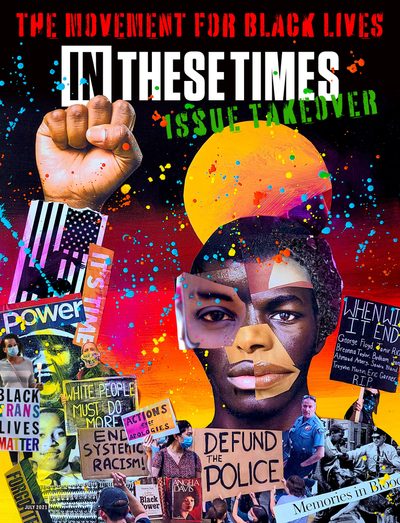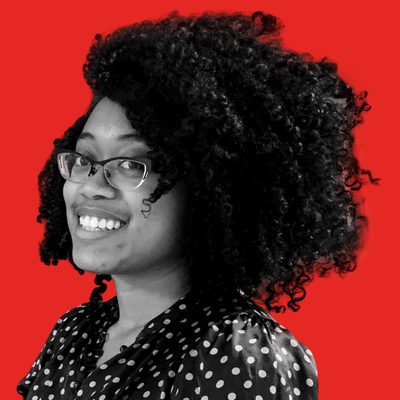The Utopic, Love-Centered, “Liberation Oasis” on Chicago’s South Side
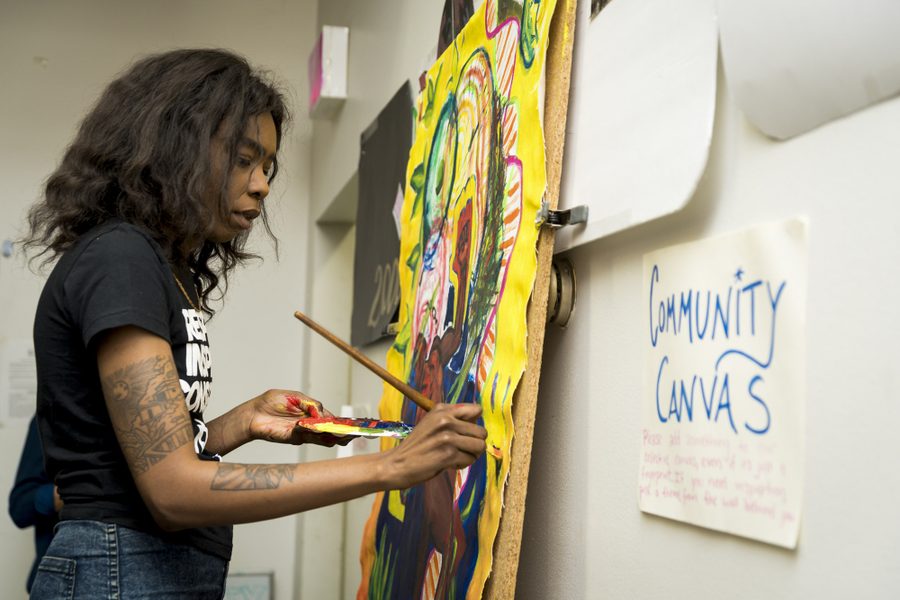
Artist bria royal paints on a community canvas at a discussion on how to “build a Freedom City” March 12, 2018, led by the #LetUsBreathe Collective, the Resist. Reimagine. Rebuild. Coalition Chicago and the Illinois Humanities Council. Photo by Sarah-Ji
Damon Williams, a co-founder of the #LetUsBreathe Collective, talks radical space-building.
Damon Williams is a lot of things — a hip-hop artist/performer/podcast host/interviewer/organizer — but the term that lets him “remove all the slashes,” he says, is “movement builder.” He is also the co-founder and co-director of the #LetUsBreathe Collective, a Chicago-based abolitionist group of artists and activists originally created to support the 2014 Black Lives Matter uprising in Ferguson, Mo., whose work has grown into what is now known as the Breathing Room. The Breathing Room reminds me of the community centers I went to growing up, but it’s more than that. Damon describes it as “liberated space” that is not “under the market” or “commercial” — something “public, but not government-controlled or state-run.” There are events, there’s art happening, it’s covered in murals, there’s a community garden being built. The people there, some of whom also live upstairs, offer their time without pay or receive small stipends.
The first Breathing Room sat in Chicago’s North Lawndale neighborhood — a Black community with a long history of disinvestment and housing predation — near the site of the 2016 Freedom Square occupation. (#LetUsBreathe launched the 41-day occupation against the adjacent Homan Square, a Chicago Police Department “black site” infamous for torture.) Freedom Square looked like chaos but was beautifully orchestrated, with kids running around asking for rides to the pool, volunteers and drop-offs from around the city, a library and a Free Store, where clothing and donations are “sold” free of charge.
I really got to know Damon as an organizer with the launch of the Black Abolitionist Network’s Defund CPD campaign in summer 2020. We were part of the training team that, during the July Fourth weekend, hosted mass resistance trainings across the city of Chicago. The last site for in-person trainings was an empty lot across the street from the Breathing Room’s current site in Back of the Yards, a South Side neighborhood.
What struck me about Damon was how he prepared and talked about movement and liberation work in a way that really connected with the folks who showed up. During our huddles before training sessions, his ability to ground us in the importance of what we were doing and offering to our community was a gift. His style of training and facilitating is in tune — actively listening and lovingly pushing folks to be principled in something he calls a love politic.
I spoke with Damon for In These Times about art, love and movement-building.
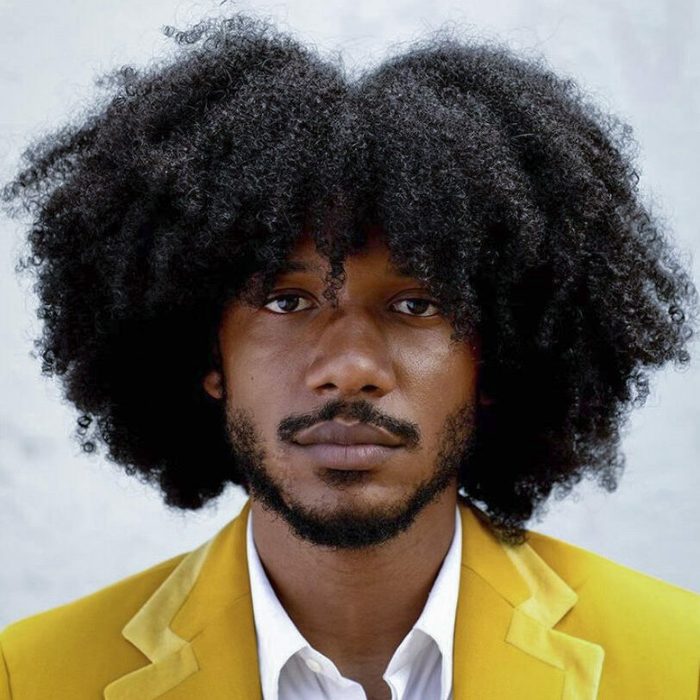
When you described yourself as a “movement builder” I was like, “I want to talk to him. I want to hear more about that.” Let’s start with how the Breathing Room came to be.
DW: In those first two years after Ferguson, the movement was hyper-rapid response, hyper-oppositional, hyper-performative in a lot of ways. Protests and meetings were pretty much the only way we were gathering.
In internal criticism, it came up that some meetings resembled corporate or academic spaces, which are not accessible for folks who were systematically excluded or marginalized in such spaces. And protest is not physically accessible for everybody and not politically accessible to everybody, depending on relationships to the police and to the state. Turning it up on the cops is not a thing that everybody feels comfortable doing.
We wanted to make movement space more accessible. We knew we needed a physical space — a space for organizations to meet or to perform or to craft. That was one of the first things that came up in our visioning sessions here in Chicago and back with the folks in Ferguson when we did outreach.
Some partners who had supported our trips down to Ferguson had a lease in an old grungy warehouse in North Lawndale that was being refurbished as an artists’ loft. They were white people, so being aware of their position and where we were at, they asked whether we wanted to do something with it. On MLK Day 2016, we did the first Breathing Room event, a six-hour event where you could get free healing modalities — guided meditation or Reiki or massage — and a free meal. There were also workshops on things going on in the city, like the grass gap [the racial disparity in Chicago police enforcement of marijuana laws].
That was also the formal launch of our Free Store, the forefront of our mutual aid approach.
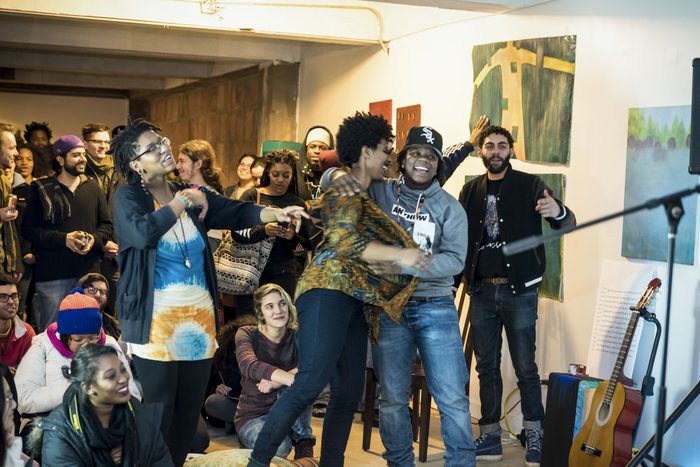
We were able to use that space to do events monthly, like an open mic. You could come up to do your rappity raps or sing your songs, but we weaved in there a featured person that would do a five-minute teach-in or report back from an action or some other political education, or featured performers and presenters.
Our original vision was — we want somebody to just be walking down the street and see something is happening and join. So as it got warmer, we started doing our Free Store on the sidewalk and inviting folks in from the community. But the man that owned not only that building but the whole block told the leaseholders of our space, “I put bars on this building to keep these people out and you’re letting them in.” It was systemic racism, land ownership, slumlording at the highest level.
At that time Su Casa, a Catholic Worker space here on the South Side, had a vacant building with a lot of damage that was building up utility costs. They put a call out to organizations to steward the space. We thought, “What if this monthly event, which is this imagined utopia, is a 24/7 existence?”
So in summer 2016, we were supposed to be rehabbing this building, and then the Freedom Square action emerged as a live-in occupation. Living the experience of 24/7 open-air organizing, youth engagement, dealing with houselessness and folks in need of shelter and health needs and addiction services and building out a library and food all of the time — all of that practice — informed how we then came into the Breathing Room.
And you were also cohosting a weekly podcast during this time! I love listening to AirGo and your down-to-Earth, warming conversations with organizers and artists. You featured Angela Davis earlier this year in your — wow — 270th episode since 2015.
DW: Having Angela Davis on was very much a capstone moment. She embodies so much of what the show intended to be. Angela Davis, Fred Hampton and Huey [Newton] were probably the three people, as I’m coming out of school, that embodied what I aspired toward.
There’s so much content of hers out there, but on the flip side, when you look at all of the clips of Fred Hampton, it amounts to less than an hour total. That felt like a real historical tragedy. So when I saw this intersection between this youth arts renaissance in Chicago from like 2013 to 2016/2017 and an emergent Black liberation movement, I wanted to capture the movement we were building in real time, understanding it is going to have historical significance.
And that’s the intention behind AirGo. Whether it’s Page May or Charlene Carruthers or Jamila Woods, there is going to be at least an hour of them naming their perspective, their story and their contribution, to create this living archive.
I’m so grateful for that, for this gift for our movement spaces and for the future. That’s something that I remember you talking about when we started working more closely together — about how our movement spaces are always already intergenerational. Let’s segue back to the Breathing Room, though, and this form of independent, truly community-embedded institution-building. What are some of the Breathing Room’s big success stories?
DW: Man, it’s hard because it always feels so heavy to talk about. Some of the successes have been really difficult to get to.
We had to figure out how to use the space as a resource for people in need while accounting for the capacity of the space and of the organization. We’re not really a resource organization; we don’t have staff in any type of way. It’s very much this crowdsource, grassroots, DIY, “we’re just the people that show up and get transformed and keep showing up” type of approach.
We were doing these art classes, and many folks who participated were living in a shelter down the street that closed very abruptly, very violently, during the holiday season in 2019. And we ended up making space at Breathing Room for several of the families and one of our teaching artists.
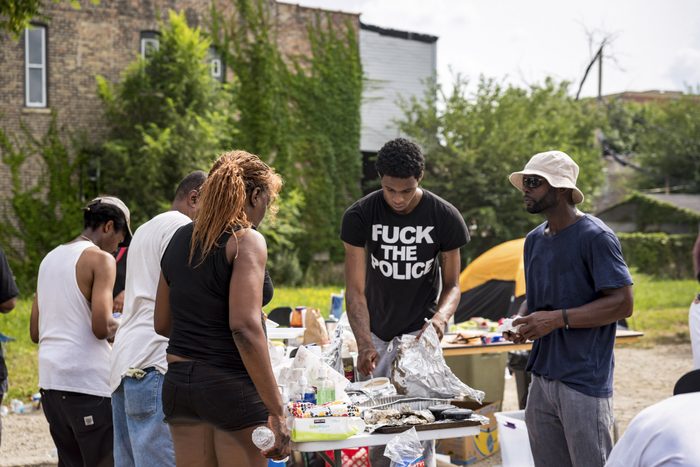
We had to figure out how to support someone who is navigating case management services and institutions, which aren’t very accessible for the people that need them, and then we also had to build an abolitionist political education program around this housing crisis and home as a concept.
Some of that was hard, and some of that was not what we had committed to do. So we were navigating our own relationships and boundaries, the reality of limited space, while meeting folks at a point of having experienced trauma and of going through continued trauma.
I often felt like we were failing. But also it was really beautiful: The folks living there were investing in and being part of the programming, or stewarding the space, or managing the Free Store, or supporting our Everybody Eats program.
Our tenets are “heal, organize, create,” in that order. We created space for folks to be able to heal and then helped place them in their own homes.
The reason why I said it’s difficult is because there’s a very liberal, nonprofity feeling in claiming that as a success story, but that has been the most substantial work. And it was a thing we did not expect to do. But we were trying to be the radical community we say our society needs.
That vision also really shaped our actions in 2020. One of the things we were saying coming off the experience of Ferguson is: how do we create space to prepare, propel or respond to Chicago rising up, because we know these conditions exist here too. When 2020 happened, we were in the midst of planning a follow-up to Freedom Square called Free Town. We wanted to build community through mutually centered, open-air, creative organizing. The pandemic stopped that. But much of what ended up happening organically throughout the city around defunding the police and mutual aid networks was right in that vision of what we were trying to plan, and Breathing Room was able to hold a lot of that. Hold trainings, hold the debriefs, hold resources, hold art builds.
The terms we threw around were “movement-building headquarters” or “liberation oasis.” Even within our limitations, we could meet some of that need and serve a purpose for the movement, and so that feels like another of the greatest successes.
What you just said reminds me of a beautiful thing theorist and writer Fred Moten said in an interview recently. His aunt was always on the verge of being evicted from whatever house she was in. But she was also always “giving away the space”; folks could always come through.
Another quote that comes to mind as I’m hearing you talk is that Toni Cade Bambara quote about making revolution “irresistible.” What do you think of that idea?
DW: That quote has definitely taken on a life of its own in the last few years and almost sometimes too much; people who want to talk about revolution, they just want to be irresistible. I’m joking, but I think the thing that has embodied that quote most, in our experience, is a “love politic” directly connected with this very holistic honesty.
What we saw at Freedom Square is that when people see there is color, see an attempt at creation (even if it’s not professional or beautiful), and see vulnerable people — or people without material access — having their needs met, something within us says, “I know that’s my human responsibility and my society doesn’t give me many opportunities to do this.” People love to see babies being loved on, people love to see somebody telling the truth, people love to see somebody showing up and being consistent. That is what is irresistible.
Our Free Store has carts that we designed with colorful love or political affirmations. Before our Covid shutdowns, people named those as something they show up for. A lot of elders say [it makes them] remember spaces that existed. When people see a stewarded space that has this love-centered radicality, they really want to be part of that.
That’s really beautiful. I really appreciate the emphasis on showing up and consistency. At Liberation Library, we also emphasize that for our volunteers, especially when considering any work related to our young readers inside.
I also want to get your reaction to this quote, by the famous radical activist and artist Paul Robeson: “The artist must take sides. He must elect to fight for freedom or for slavery. I have made my choice.”
DW: Yeah. Oh man, I always am making choices that are accountable to this tradition. As a creator, as a performer and as a person that shows up in politicized and political spaces, you have to always be asking: is there any way this is benefiting me in a way that is continuing the oppression of the most vulnerable, less privileged, marginalized people? Whether that’s who you take money from, where you perform, how you teach.
And that’s a really hard choice, particularly while trying to survive or understand capitalism or create home or create family yourself.
Boom. Wow. You are so wise. I wish we could talk like this more.
DW: That’s been one of the joys of this year: we didn’t really know each other before Defund CPD popped off, and now we do. So I’ve been grateful as well.
Bettina Johnson is co-founder and current steering committee member of Liberation Library in Chicago, an abolitionist books-to-incarcerated youth project. Bettina is also a facilitator for other prison-industrial complex abolitionist campaigns.
